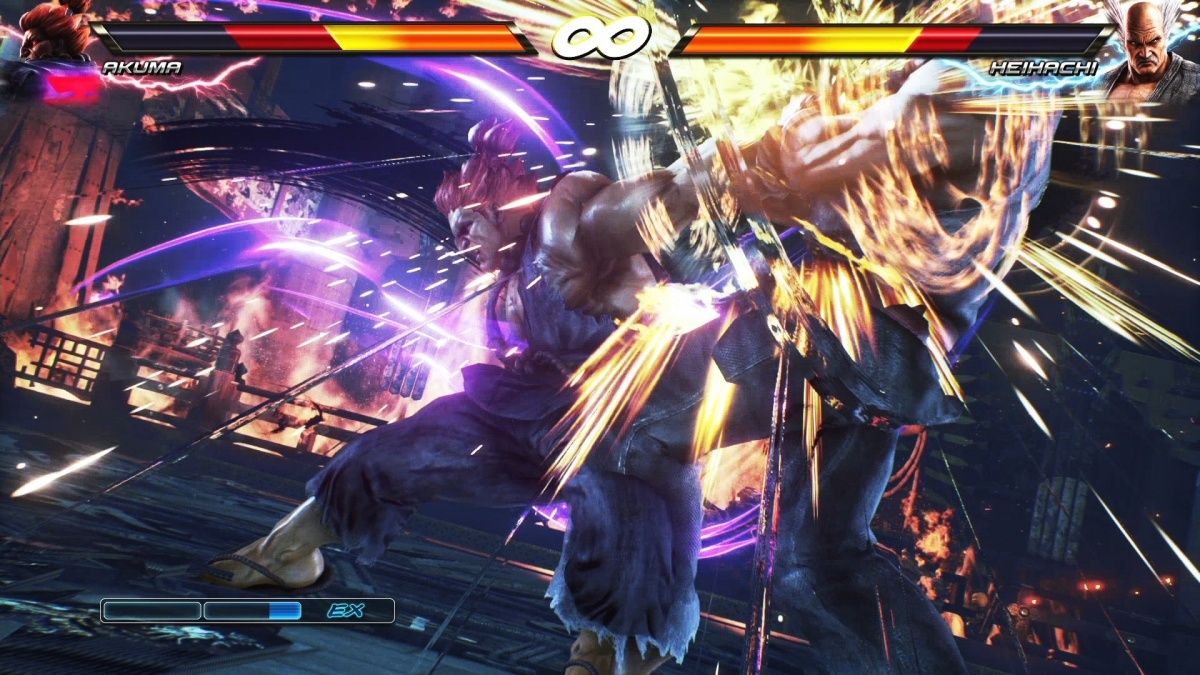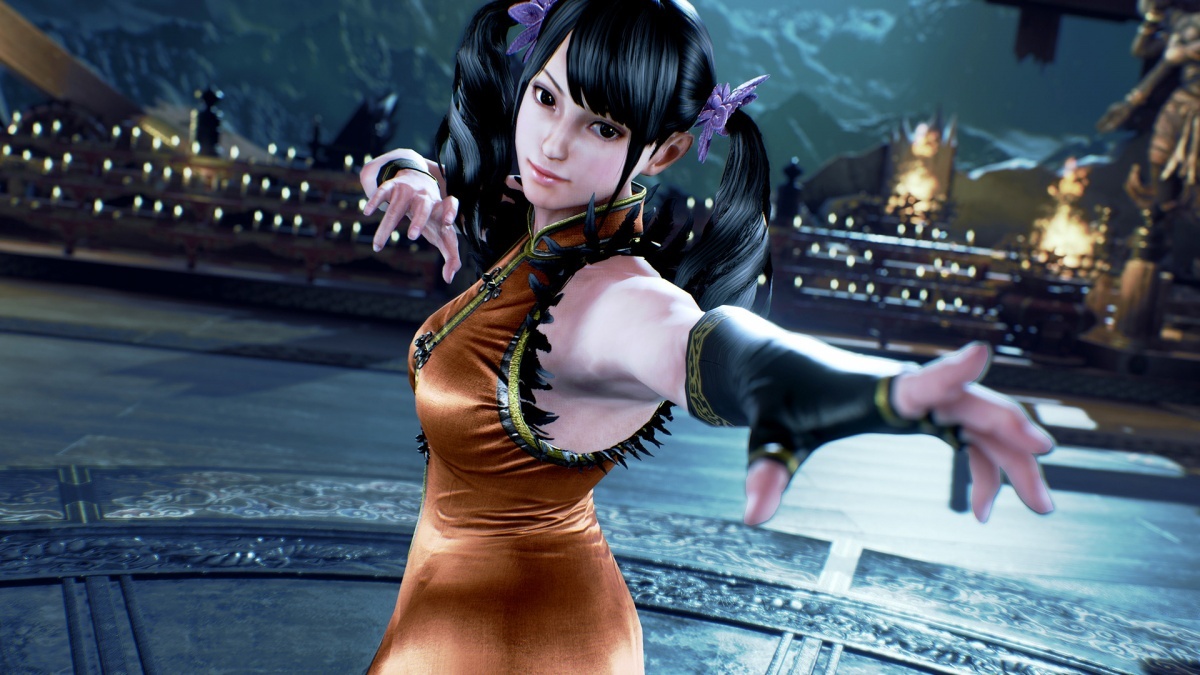Tekken 7 (PlayStation 4) Review
By Gabriel Jones  04.06.2017
04.06.2017

Once upon a time, the King of the Iron Fist tournament was the battleground for the world's mightiest fighters. Now, it's a front devised by Mishima Zaibatsu in order to further its goals of world domination. Its rival, G Corporation, desires the same. Their conflicts have led to a new era of chaos and darkness. Somewhere in the centre of all this madness are two men, Heihachi Mishima and his son, Kazuya. For decades they have tried to destroy each other. Perhaps, this time, the battle will be settled once and for all, but don't hold your breath. After all, despite their propensity for getting tossed into bottomless ravines or active volcanoes, these warriors never stay down for very long.
Mastering the Tekken series has always involved a very serious learning process, one that seems at odds with its boisterous first impression. The techniques that the colourful cast is capable of are simple to perform, and stringing together combos isn't all that difficult. Given a short amount of time, anyone can develop the necessary muscle memory to pull off an incredible series of moves. This makes for a fighting game where anyone can hop on to do some damage, but even to this day, the most essential skills and strategies elude all but the most dedicated.
Execution isn't just about being able to perform complicated special moves; it can be something as surface simple as movement. Almost the entirety of high-level Tekken play revolves around being able to move around the arena with the grace and ferocity of a swan. One of the most important skills the player can learn is the back-dash cancel. Sometimes referred to as a "Korean back-dash," this technique is very effective at quickly creating space and causing attacks to whiff. Thanks to the Internet, there are countless tutorials and videos discussing this maneuverer. However, even with the release of Tekken 7, Bandai Namco still leaves players in the dark.

Granted, back-dash cancels are not easy to perform. They require quite a bit of dexterity and an almost familial link between the player and their controller of choice. Even the pros have trouble with them. Still, some effort should have been made to explain this, and many other techniques, in a tutorial. The lack of explanation for its mechanics, aside from the clunky "Combot Training" mode in Tekken Tag Tournament 2, has always been a sticking point in the games. It seems that Bandai Namco incorrectly assumes that its players are already very familiar with Tekken and its many intricacies. When it comes to fighters, there will always be newcomers. The importance of a good tutorial mode can't be understated. Why this franchise never took cues from titles like Virtua Fighter 4: Evolution and the Guilty Gear Xrd series is anyone's guess.
The beginning of "The Mishima Saga," AKA the story mode, is a perfect metaphor for what the developer thinks of the learning process. While a young Kazuya mounts a desperate attack, Heihachi effortlessly shrugs off his futile attempts, before throwing him off a cliff. What follows is a mostly unexciting romp, where a disconnected and quite bored narrator explains a very messy relationship, one that escalated to a war that has engulfed the entire world. The chapters include a variety of one-on-one fights, many of which have unique conditions, such as opponents with regenerating health. There are difficulty settings, but they're implemented in the poorest fashion imaginable. The easy setting forces the player into auto-combos whenever they press the punch buttons. The harder settings are just obnoxious in their efforts to give the AI opponents every advantage possible.

The inept Mishima Saga brings to mind another similar misstep: Tekken 6's scenario campaign. One can't help but also remember the aggressively bland "The Devil Within" mode in Tekken 5. It's as if the developer can't help but try to cram a square peg in a round hole, repeatedly. These poorly-designed modes don't benefit anyone interested in learning the games, and they're too overwrought to appeal to fans of the storyline. The resources spent on these disasters are better spent on the main games, which have always been utterly fantastic. Tekken 7 is the most consistent and strongest entry to date.
The key to a successful sequel is building upon the successes of its previous instalments, while properly addressing their failures. The most immediately noticeable changes involve the rage mechanic. When a fighter is low on health, they have three options available to them. The rage art is essentially a super move. It has armour, so it'll power through an attack or two, and it does a tremendous amount of damage. However, the rage art is also a commitment. It's very easy to block and punish. Rage drives are more flexible, they can be used to create openings or as part of combos. The third and most versatile option is for the player to simply hold off on performing either move. Fighters enjoy a slight damage boost while enraged, and it keeps their opponent wary. Of course, a devastating combo at the right moment can avoid the situation entirely. In any case, the comeback mechanics employed in this entry are quite remarkable.
Another new addition is the unique property known as "power crush." What this means is that every playable character has an armoured special move, so they'll ignore hits while it's being performed. However, they'll still take damage, and low attacks or throws will stuff their power crush attempt. When used sparingly, these techniques are great for countering opponents who rely too much on jab strings, or for breaking out of corner pressure.

The roster has seen another shake-up. While a few fan favourites are MIA, the cast is as strong and diverse as ever. The new additions are for the most part very solid and will adapt to any level of play. Katarina is perfect for newcomers thanks to her simple yet powerful move set. Someone seeking a fighter that's a bit more unorthodox would do well to learn Master Raven. Josie the model/kickboxer has great fundamentals and impressive quickness. Claudio has some unique tools and an amazing hop-kick launcher. Shaheen, like the majority of the characters, is altogether a viable contender. As with practically every other fighting game, there are tiers, but they don't matter too much. That said, Lucky Chloe, Gigas, and Akuma tend to struggle a bit more than the rest. In the right hands, they're still extremely dangerous; they just have to work a little harder.
More so than ever, the typical match is dynamic, kinetic, and exhilarating. Every element blends together to create a seamless series of incredible attacks and counters. As mentioned earlier, learning impressive combos isn't all that difficult. Most of the time, the players will be focused on everything that occurs in between those critical moments. Every character having 50 to 100 moves seems daunting at first, but on average, about 15-20 of them will see regular usage. That isn't to say that those are the only ones everyone has to learn. Think of it more as a first step. Every move has significance in the right situation. Techniques that the opponent isn't familiar with can be used against them. Furthermore, the player's knowledge helps to formulate their identity. The more they understand, the more unique (and dangerous) their character of choice becomes.

Then there's the Ghost Battle mode. Fighting an endless series of computer-controlled fighters isn't ideal for training, but with the right mind set, it can still be pretty helpful. Personally speaking, the practice mode is used to learn combos and develop muscle memory, followed by taking on a series of ghost battles, using what has been learned to deal with a variety of situations. Eventually, the move to live competitors is made. The jury's still out on whether this is a sound strategy, because losses are incurred quite often. When it comes to fighting games, experience is what matters most, and that requires a lot of matches. Again, the Ghost Battle mode isn't perfect, but every little bit helps.
As one can expect from an online-enabled fighting game, there are both ranked and player matches. However, as of this writing, the chances of getting a ranked match going are zero. Player matches fare slightly better. Although, expect to sit through several "connection lost" messages. If and when a connection is established, the fights are generally smooth and lag free, provided both players are in the same region and have solid internet. Right now, anyone looking to get their competitive fix should consider hosting or joining the online tournaments. They work very well, and provide some nice rewards to anyone who manages to win.

Cubed3 Rating
Great - Silver Award

In short, Tekken 7 is a phenomenal fighting game, but it's not without issues. Players have hundreds if not thousands of exciting matches to look forward to. Grasping the complexities of movement and learning characters is an involved process that'll cause anyone to lose track of time. However, the developer continues to focus their energies on features that simply aren't worth the trouble. The Mishima Saga, with its cheap battles and dishwater dull story, is a relic from an era best left forgotten. The broken matchmaking is also a very serious issue, so hopefully it's addressed in short order. Still, this fighter is highly recommended.

![]() 8/10
8/10
![]() 0
(0 Votes)
0
(0 Votes)
 Out now
Out now  Out now
Out now  Out now
Out now  Out now
Out now Comments
Comments are currently disabled

 Sign In
Sign In Game Details
Game Details Subscribe to this topic
Subscribe to this topic Features
Features





 Top
Top

